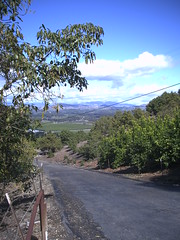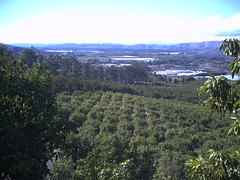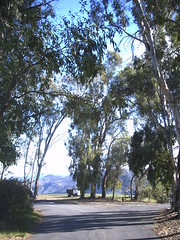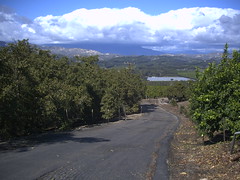Sunday, our location was one of those hillside orchards, and as I pulled off the freeway into what I thought was still a mostly agrarian community, I got a nasty shock.
Within the past few years, vast tracts of once-farmland have been subdivided and turned into housing developments with names like "Avocado Acres" and "Terra Bella Estates". It's happening everywhere, so I don't know why I didn't expect it this time. I guess I figured that food production was a pretty high priority.
Silly me.
With the gentrification marching onward (thus making urban areas increasingly unaffordable) and housing prices continuing to skyrocket, farmland becomes less and less financially viable - so Southern California is quickly turning into a region of wall-to-wall tract housing and strip malls.
Views like these are, sadly, now very rare:




I understand the need to build more housing.
It just makes me kind of sad to see Southern California chewing up our agricultural heritage and spitting out acres and acres of identical Mediterranean-style stucco houses.
13 comments:
But... America is HUGE! You have tons of space.
Don't you?
It is not really about how much space we have but what is being paved over. In this case it is the land that grows the food we eat. In the 1950s Los Angeles County was the #1 county in the entire US for production of food and other agricultural products. Yes, we live in a global economy but that comes at tremendous cost - just think about how much fuel it takes to get a piece of produce from another county to your table. There is real environmental and social value to having locally grown food. That is what we are losing when the farms in Southern California are paved over.
I grew up in that part of CA, and one of the best Mexican restaurants still exists in Camarillo-it's "El Tecolote", a funky old adobe building near the railroad tracks. And yes, the loss of farmland in So Cal is irreplaceable.
Doom/Blondie - What Kateroo said.
However, Southern California's agricultural heritage and population boom (both pre WW2, postwar, and modern) came at a very high cost.
For non-Los Angeles based readers, here's a bit of Southern California history:
William Mulholland
Southern California Water Wars
Your blog features a unique and often humorous behind-the-scenes perspective of the "biz". Please leave the environmental stuff to others.
CHINATOWN. That is REQUIRED viewing for anybody interested in the history of Southern California, "Kittycat" (best said by Roman Polanski, knife in hand.)
Your pictures of Camarillo remind me of north Orange County when I was a kid back in the '60's... Reminds me of the Dave Alvin song "Dry River". It certainly doesn't look like that any longer. I'm thinking of starting a movement to save Brea Canyon, but the plans for the condos have probably been in the works for years...
*sigh*
- Pat Hough
wow.
thanks for the info.
you learn something every day.
peace and love
Doom/Blondie
xx
Agriculture and the Motion Picture industry were the two forces responsible for the huge number of people settling in California. Orange groves and sunshine, movie stars and "The Good Life" constantly on the silver screen. The two are intertwined in the fabric that made Southern California. So I think that it is valid in a movie worker bee's blog to discuss this issue.
So next time someone comes along and wants to put higher density housing in your urban neighborhood make your views known and support it. As long as people keep having children, those children will grow up and need a place to live. It's naive to think that we can have it both ways. That we can preserve each and every little 1950s stucco house in the Fairfax district and can also preserve each and every orange grove in Camarillo.
You don't even need to leave the LA city limits to witness the devolution of what was once a breathtakingly beautiful place. Sit down and watch an old Harold Lloyd silent film and you'll see the City of Los Angeles only a decade after the turn of the last Century, looking clean and well-designed, with lemon groves and quaint bunaglows as far as the eye could see. Those same filming locations are now grungy corners in Hollywood that are packed with cars, people and junk. Whenever I see hidden bits of forgotten architecture, even from later years, like a Neutra house in the Hollywood Hills, or the old Art Deco Post Office and Police Station in Santa Monica, I think that we've truly lost our collective ability to intelligently design the built environment. As long as people continue to scramble to live near the ocean, and as long as profit is elevated above all else in the name of progress, you're going to see many more Camarillos.
i agree with meg, that agriculture and film are intertwined in the history and developement of so-cal. and at one time the way both industries hired were the same. everyone waited around at the gates to get a job.
and certainly most of us in this business are taking part in gentrification or sprawl in one way or another.
and like most workers in this town most of us arent from here.
and both industries are looking for higher profit through cheaper labor, either by importing labor or exporting the industry.
both industries are here for the weather.
and we below the line folks dont have to pick just apples. we can work on many different projects. film, tv, video, commercials, porn, are all ripe for the picking. hey it's pilot season!
It IS possible to do things another way. It's just not as financially rewarding to real estate developers.
For example, Oregon's land use laws set growth limits to the sprawl of Portland. Much of the land in the areas surrounding Portland is Exclusive Farm Use designated and can't be built on without agriculural income (or existing homesite), or subdivided below 15 acres. Even then, 1 home per 15 acres unless the land was a smaller size before the law was passed.
Friends of mine have a place 45 miles from the heart of Portland, and there's nothing around but farms, vineyards, orchards and trees. You can be in Portland in an hour on a good day.
Mind you, there's still plenty of suburbia, but it's not ALL suburbia, and it's easily avoidable. And yeah, I like getting locally grown peaches there - the ones not made for supermarket shelf life - a whole different fruit.
Um, I probably shouldn't have written this to Californians - the Oregon Secret Police will be knocking on my door soon. LA is perfect. Stay in sunny perfect LA. I lied, it's all paved and it always rains up there in Oregon. Always ra-
Post a Comment